Your Complete Guide to Achieving Digital Transformation
Last Updated on November 30, 2023 by Owen McGab Enaohwo

The digital age is not just an age of technology, but also business and industry. Just like in any other era, some companies succeed and some don’t.
Digital transformation is changing the customer experience. In the automobile industry, customers are more inclined to buy a car from virtual test drives. For example, some automobile companies have invested in 360-degree videos of the car which include the interior and exterior walkarounds. Fifty-six percent of car-buyers said the 360-degree video can convince them to buy a car without even driving it. BMW is taking advantage of this with its #BMWStories video campaign, and those who haven’t joined the queue are left behind.
Digital transformation represents the most significant business and organizational change of our time. It is a shift from companies providing goods and services to customers to an era where companies change their mindset so they can truly take advantage of what technology has to offer. With digital transformation, organizations can provide value in new and previously unimaginable ways.
Digital transformation is not easy. It requires thoughtfulness and planning before diving into the next big thing. For some reason, people are always looking for the newest shiny object without considering the consequences of their actions. Don’t be that person! Start with what you have today and evolve as your business changes around your new solution(s).
Achieving this can seem daunting at first glance but it doesn’t have to be complicated or expensive. You just need to understand where your business currently sits so that when it’s time to make decisions on new technology, you’re ready for success.
This article provides a comprehensive overview of what digital transformation entails, why it’s important, how to plan for it, and how you can lead your organization through it successfully.
Digital Transformation Full Guide – Chapter Index
Chapter 1: What is Digital Transformation?
Chapter 2: Types of Digital Transformation
Chapter 3: The Key Drivers of Digital Transformation
Chapter 4: Digital Transformation Technologies
Chapter 5: The Six Building Blocks of Digital Transformation
Chapter 6: The Future of Digital Transformation
Chapter 7: Challenges to a Successful Digital Transformation Strategy
Chapter 8: How SweetProcess Can Help You Achieve Digital Transformation
Conclusion
Chapter 1: What is Digital Transformation?
Digital transformation is the process of using digital technologies for evolving business models. Transformation is revolutionary, not evolutionary.
Digital transformation requires organizations to embrace new ways of doing business and new ways of leveraging technology. It’s not just about the development of innovative apps but making sure they’re relevant to your business stakeholders. Businesses need innovation to stay relevant, but they also need digital transformation because the rate at which things change in today’s world is so rapid that if you don’t keep up with it, you’ll get left behind. By closely looking at how businesses operate and studying people’s behaviors when they use technology, we can develop technologies specifically tailored for solving their problems.
In an era where technology is constantly changing, it’s critical that companies are willing and able to make changes and integrate new processes. This often means walking away from long-standing business processes in favor of relatively new practices still being defined by society as a whole but with the opportunity for much more success.
Digital transformation in business is changing the way that corporations interact with customers. There are many ways that digital transformation has impacted businesses, including the ability for employees to work remotely. Digital transformation has also allowed companies to have a more hands-on approach with their customers by using an online platform.
Digital transformation is not a one-size-fits-all project. It requires both technological advancements as well as changes to the business process and corporate culture within your organization for it to be successful. This often leads many people who are involved with these projects to think that they can just do “X” without considering what else needs adjusting in order to make sure there won’t be any problems or issues later down the road (which could happen).
The reality: you need more than good technology if your success depends on transforming into an increasingly digital marketplace, so differentiating yourself from competitors becomes key.
History of Digital Transformation
Digital transformation has been an ongoing trend for some time now, but it is only recently that it has come of age. The first stage was the replacement of the business monolith with agile development methodologies and web-first or mobile-first approaches to design and UX principles. This led to greater agility in deploying new features, products, and services to customers. As the world moved toward becoming more digital, this gave companies an edge in their respective markets.
The next stage was about using relevant customer data to improve the targeting of marketing messages and make these more personalized. This led to a rise in ad tech firms that made real-time bidding for ad placement easy and accessible. Amazon and Netflix are two companies that used big data techniques to make personalization easy to implement, giving them a competitive edge.
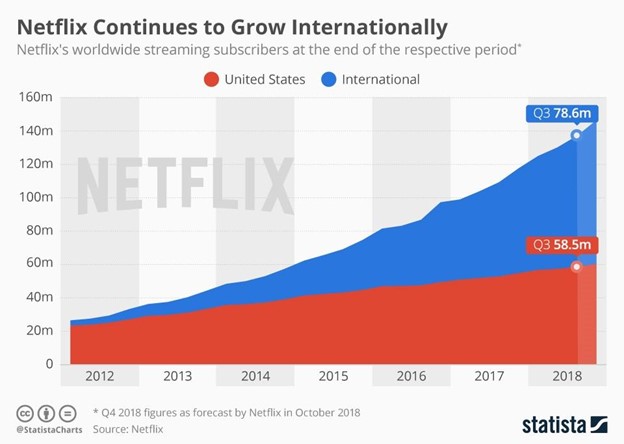
Then it was all about analytics—using machine learning to analyze customer behavior to improve targeting, recommendations, and fraud detection. This trend is just starting now but will become increasingly important as targeted marketing becomes more relevant than mass-marketing campaigns. Over the next few years, several unicorns (start-up companies worth over $1B) will be built on this foundation of reams of personalized data mined by machine learning algorithms. As these companies emerge it will bring new challenges for ethics committees and consumer backlash against too much personalization, so it will be interesting to see how this develops.
Finally, we are now starting to see chatbots and messaging platforms used as a new interface for customer engagement. So far chatbots have been very simple, but experts believe that there will be huge advances over the next few years. WhatsApp and Facebook Messenger both support bots and will be worth watching closely in the future. As with all emerging trends, there is always hype—these technologies could fundamentally change how we interact with businesses, or they may just become another tacked-on feature that gets dropped within a few years of being tried.
Why Do Businesses Undergo Digital Transformation?
Businesses want to make more money. The biggest factors in running a successful business are maximizing revenue and minimizing costs.
Digital transformation is what enables businesses to do this with the least effort possible. It helps businesses deal with customers better through automated marketing solutions, track website traffic and interactions through digital analytics, use social media for customer service outreach, produce products at a lower cost thanks to 3D manufacturing technologies, and improve their supply chain processes using smart IoT applications.
In short, digital transformation transforms businesses from being basic “operating system” providers into being partners of their clients that enable them to achieve their own profitability goals by transferring a significant amount of the operational efforts to companies that have embraced the forthcoming digital revolution.
However, not all companies are getting it right with the movement toward digitization. There are some businesses out there that have gone overboard with their investments in new technology and have forgotten about their workforce in the process of becoming digital. What’s even worse is that many of them don’t even know or realize what made them lose sight of their employees’ needs during this time.
Who is Responsible for Digital Transformation?

Chief information officers (CIOs) are still the primary driver of transformation at most companies, but they don’t have complete control. According to a survey in IDG’s “Digital Business Transformation 2019” report, the CIO still takes major control of the digital transformation process: “Only the CEO has leadership over developing a workforce strategy (41% CEO vs. 36% CIO) and determining the metrics of success (47% CEO vs. 36% CIO). Companies represented in the survey averaged 14,000 employees.”
TechTarget’s “CIO Moves Forward” report explores how CIOs are managing the journey to next-gen digitalization and how they can prioritize their efforts. The research details a landscape shaped by external forces such as increased pressure from business units, the need for a new workforce strategy, and a shift in tech leadership.
Chapter 2: Types of Digital Transformation

Digital transformation can be categorized into three types. They are:
- Business process transformation
- Business model transformation
- Organizational/cultural transformation
1. Business process transformation
Business process transformation brings about dramatic and visible changes in businesses. It is the evolution of business processes that enable organizations to achieve their strategic goals and attain superior performance over time.
The objective of business process transformation is to significantly improve efficiency, effectiveness, and agility to gain a lasting competitive advantage. It is carried out by designing new processes for a high degree of electronic automation, leveraging on the latest technologies, or imbibing new technologies such as cloud computing, thus creating a perfect organizational platform for higher levels of business excellence and improved productivity.
By definition, business process transformation is the structural re-engineering by any organization with technological assistance to achieve its goals through the adoption of better business processes. This is done by reviewing the existing processes, identifying the opportunity for improvement, and implementing new technologies to get desired results.
We have seen successful examples of business process transformation: BP, Suncor Energy, and TNT Express are a few examples of successful implementation of business process transformation.
2. Business model transformation
Business model transformation is the process of transitioning an organization’s current business model to one that is sustainable in the future. In years past, the information technology (IT) department was a cost center. But as business models have evolved to one of the more open and collaborative models, IT is now expected to be a revenue generator and enabler for innovation and operational excellence. As such you will need to choose a business model to use: either top-down, by understanding strategic objectives, or bottom-up, by understanding what’s going on in the trenches.
The first step of business model transformation is to recognize that you are in the midst of this evolution. As a result, technology teams are being asked to do more with less. They’re also being asked to make things happen faster and improve the overall user experience. This is placing enormous pressure on IT organizations, which must now balance multiple initiatives with limited resources. The problem isn’t only about simply doing more work but how best to do it.
The second step is to understand what your forward-looking vision for IT looks like at this point, where business value optimization comes into play as an important component of your corporate strategy initiative.
After all, if you don’t know where you’re going, how will you know when you get there?
Business value optimization is all about finding the intersection of business and technology which requires a new way of thinking and doing things, especially as it relates to better aligning and streamlining your IT resources for improved business outcomes. It’s about achieving greater value from your existing IT investments by improving key performance indicators such as cost-effectiveness, quality, efficiency, and responsiveness.
For example: Let’s say your organization wants to improve its time to market (TTM). How do you accomplish this? By identifying the time spent on manual processes—perhaps creating documentation that has no bearing on revenue—then increasing automation or shifting resources away from nonessential tasks toward those that have a direct impact on the bottom line.
In this case, business value optimization is all about linking your TTM goals to overall enterprise objectives, and then working collaboratively with business stakeholders to create more efficient processes that support revenue-generating activities.
The third step is to understand how technology solutions can generate more available resources for increasing agility and innovation, or reach into other parts of the organization that might benefit from these resources. This requires you to collaborate with non-IT departments so they can become aware of and adopt new technologies and solutions. It also means taking a hard look at where IT dollars are spent today and whether those expenditures directly support your top initiatives or if there’s room for improvement. After all, who better than IT knows where the pain points lie?
The fourth step is to put your plan into action. This requires you to leverage an iterative approach that focuses on a continuous cycle of improvement and assessment. As a result, you must begin to break away from the traditional software “advance sell” model by streamlining processes and technologies so they become more agile and cost-effective.
Technology is no longer just about doing things faster but also better, smarter, and with greater visibility into the outcome.
3. Organizational/cultural transformation
Successful digital transformations depend on aligning with the company’s culture and values. If an organization loses faith in its own corporate culture, productivity will drop as employees lose initiative or feel like they can’t make a difference at work. Digital technologies adoption is crucial for success; slow uptake could lead to missed targets which ultimately results in lost revenue and brand value too.
A survey conducted by the market research firm Vanson Bourne found that employees are feeling increasingly disconnected from their organizations, with 52% reporting they feel “disengaged” or “checked out.” As a result, there is potential for organizations to lose massive amounts of money in production costs.
These results are documented in Gartner’s report The Changing Nature of Work: How to Eliminate Digital Friction to Boost Productivity and Resilience. According to Gartner, a significant percentage of employees feel disengaged from their work.
In addition to this, Gartner states that the majority of managers have been struggling with how best to manage staff in an increasingly multicultural and technologically connected workplace, where traditional management styles can often feel outdated.
Digital transformation is not just about improving workflow or increasing efficiency. It’s also an opportunity to transform the way we work, collaborate, and communicate with one another—all in an effort for greater success.
It is important to note here that digital transformation is not just about digitization.
Digitization is often seen as a mere tool or technique in achieving digital transformation. When we think about digital transformation, we need to start thinking beyond digitization and go right down to our business models.
Digital transformation is…
1. A philosophy rather than some marketing hype (Amazon)
2. An opportunity instead of a threat (KPMG)
3. Not just about technology (Forrester)
4. About re-imagining your business from the ground up (Deloitte)
5. A thought process rather than a dictated mandate (HPE)
6. About thinking of everything as a service and infrastructure (Symantec)
7. About using data to make better decisions (MSI)
8. About the digital transformation of your business model, not just your IT systems (Cisco)
9. Not simply about becoming more efficient by digitizing what you do (IBM)
10. A main driver for the transformation of business models (McKinsey)
11. Needed to support the shift to intelligent customer experiences (Tata Consultancy Services)
12. The use of state-of-the-art technologies for better performances, higher productivity, and lower costs (ITI)
13. Not just about digital, but about intelligence and connection (Accenture)
14. About accelerating business evolution to unleash growth (Nokia)
15. Enhancing customer engagement through omnichannel capabilities and empowering employees through analytics and mobility (Gartner)
16. A quest for the future of your organization; either you will or you won’t (Thoughtworks)
17. The next frontier in every industry; either you seize it or get left behind (SAP)
18. A journey, not a destination (Infosys)
19. Not just about digital, but also about people (ComputerWeekly)
20. The ability to turn data into valuable business insight (Reuters)
Ten Key Elements of Digital Transformation
The key elements of any digital transformation include:
1. Customer focus

The first element of digital transformation is customer focus. Customer-driven innovation is the key to success as customers are the drivers that will provide the future for any business. The ongoing development of customer-centric approaches must be prioritized and implemented as a foundation for long-term success. Customers should be validated and their feedback must be collected to ensure that they are satisfied with what is being provided. There should be a focus on a 360-degree view of customers and potential customers to help address the needs of all stakeholders in a supply chain, ensuring competitiveness and identifying emerging trends.
A company’s customer service determines its reputation among consumers. When a company responds promptly to negative reviews or complaints, it has a better chance of turning an angry customer into a happy one. Happy customers are more likely to give positive reviews, which will in turn attract new customers.
The reward is twofold: a company can attract new customers and build brand loyalty with its existing ones, and happy customers are also willing to pay more for the product.
2. Organizational structure
One of the most important elements of digital transformation is the organizational structure. The organizational structure needs to be able to keep up with changes in technology if an organization wants to stay competitive. A new organizational structure should be developed for every new strategy that is introduced. Every business process, program, or service will have different objectives, goals, or processes that will need to be incorporated into the company’s strategic plan. Just like the strategy needs to be continually updated, so does the organizational structure.
Digital transformation is rapidly changing business models for companies in every industry. Many companies are struggling with how technology should support their current culture and processes while they adjust to outcome-based workflows. The digital discourse has moved to become more people-oriented, focusing on workforces that are empowered, creative, and innovative.
3. Change management
An important element of digital transformation is change management. Digital transformation can be seen as an opportunity for organizations to rethink their processes and include customer feedback to make improvements more quickly. It’s essential for change management to be part of the digital transformation as it helps create a culture of innovation and positive change.
In the case of a company moving to new software, for example, change management is a critical element. The software can solve problems and improve efficiencies but there will always be a period of adjustment—digital transformation is no exception. How effective change management is in these situations depends on how well it’s implemented. There are some key lessons from this that can be applied to digital transformation more broadly.
The biggest mistake is not including staff from the beginning in change management for digital transformation, from the process of deciding what changes will be involved to implementing them and evaluating the success of these changes afterward. The most successful implementations involve input and ideas for improvements right from the beginning.
4. Integration of data
Data integration is one of the key attributes of digital transformation. There are several ways that data integration can be accomplished, while some data integration efforts are more effective than others. Data staging is the initial stage of data integration where it is gathered and integrated so that it can be used in future stages. Data staging has become increasingly important in the last few years with big data, new technologies, and changing business environments.
Data integration is the process of combining data from different sources so that it can be used for analytics or other purposes. It can also mean moving data to another location for storage purposes. Data integration is not just an IT function but an entire process that should be coordinated and managed by IT, business, and line-of-business managers.
Why is data integration so important?
Big data: There has been a significant increase in the volume of data that businesses today have to deal with, both structured and unstructured. These new sources require more effort for vetting and cleaning to ensure quality data before being integrated.
Data from multiple sources: Data now comes from several different locations and is stored in both old and new technologies. Data warehouses and big data repositories create challenges for organizations to integrate the data effectively.
New technologies: The emergence of cloud computing services, mobile devices, and social media has also increased the need for data integration. Businesses are finding it necessary to integrate disparate systems more frequently, or even continuously, as new technologies continue to emerge.
Changing business environments: With the changing business environment, businesses are constantly challenged to analyze and provide insights. Data integration is needed not just for analysis, but also for developing strategies and anticipating future business needs.
5. Transformational leadership
The transformational leadership element of digital transformation is the use of data and analytics. Data and analytics are used to understand where the organization is now in relation to the future. By using data and analytics, organizations can predict when they will need resources or when a change in strategy may be necessary. The transformational leadership edge also includes leading by example. Leaders who want their employees to embrace new technology such as iPhones should use them themselves. Leaders with a transformative mindset will provide their employees with leading-edge tools that allow them to do their jobs more efficiently. Transformational leaders also focus on developing the skills of their employees to adjust to future changes due to digital transformation.
To attract top talent, transformational leaders need to have a vision for the future of their organization. Employees need to see that their employer is thinking of new ways to create value and provide customers with a unique experience. A transformational leader will show their employees how they can influence the future of their organization rather than influence its past. Transformational leaders will also show their employees how they can make a difference in the world. Employees want to invest their time in an organization that has a bright future. Transformational leaders will show employees how they can make a difference and be a part of something bigger than themselves.
The transformational leadership element of digital transformation may be the most difficult aspect to develop as a leader because leaders need to influence their employees and peers to think differently than they currently do. Digital transformation is hard for many organizations because leaders do not encourage their employees.
6. Logistics and supply chain
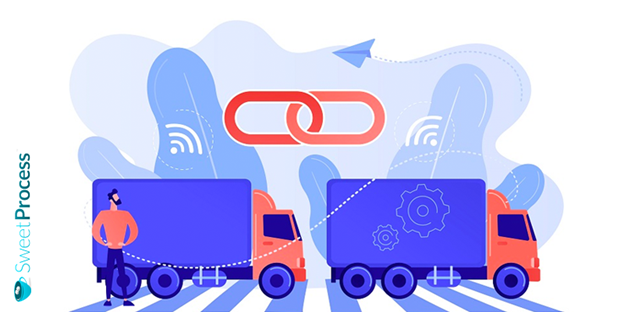
Logistics is the process of planning, implementing, and controlling the actual transport of materials. It is the management of inventory to maximize efficiency and cost-effectiveness in transportation. Logistics involves scheduling deliveries to customers, warehousing goods, planning production sequence for orders, managing inventories, designing searchable databases of orders, ensuring compliance with regulations on transportation methods, routing of orders based on historical data, and maintaining order exceptions all over the world.
The supply chain element is an important aspect of digital transformation because it impacts customer service. Transportation can occur through various means such as public railway systems or international maritime shipping lines. Transporting goods often cost more during peak seasons because more people are wanting to purchase goods at that time.
Transportation management involves creating a shipment that has the right amount of items, on the right vehicle and at an optimal time. By continually monitoring, rerouting, or changing the way goods are shipped, this technology helps to ensure that companies reach their desired destinations without delays.
Company executives also can use transportation management systems as a way to reduce costs by assigning less expensive vehicles, schedules, and routes. In some cases, there may be delays or damaged goods, and a transportation management system can automatically generate a detailed report on where items are located.
Companies that focus on supply chains have adopted a common technology platform to help them keep track of inventory and shipments.
7. Digitization
Digitization is often considered an element of digital transformation. Digital transformation is the process of moving from a predominantly analog society to a digital one. The digitization of data has occurred due to the advancement of technology, meaning there are now electronic storage, processing, and transmission methods. Information is captured in digital format, which enables different types of analyses. The digitization of society has not been restricted to information technology alone but also to other sectors including banking, accommodation services, shopping malls, etc. Digitization is seen as an essential requirement for any economy to progress further.
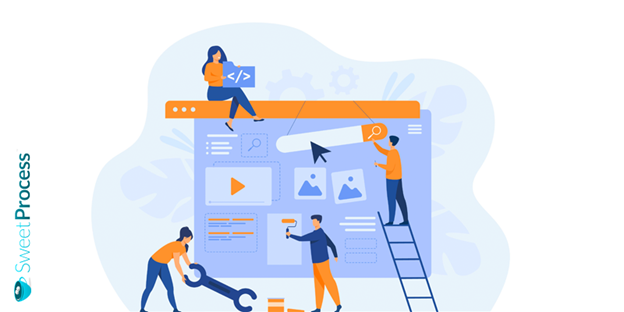
According to a survey done by the Economist Intelligence Unit, digitization has led to the development of the platform economy. Platforms provide public access, enabling many people to interact with one another. As most sectors are becoming digitized, companies are increasingly relying on digital platforms rather than physical ones for the marketing and distribution of their products or services. This has led to an increase in jobs related to the platform economy as most of these platforms are owned by businesses.
Digitization is expected to have a positive effect on society as it can provide effective communication and better customer service. In addition, it enables people from distant locations to interact with one another easily. This will lead to more collaboration among people from different locations. Computers have been used for over half a century, and the abundance of information available at our fingertips has led to an increase in productivity among employees as they can use digital tools to find relevant data for their work.
8. Internal customer experience
Traditionally, the customer experience, or CX, of a business was reserved for after-sales service and customer care. But thanks to the rise of digital transformation and consumer expectations, businesses now see it as an opportunity to differentiate themselves on a level beyond just price or quality.
Salesforce is using artificial intelligence (AI) to better understand its customers. This end-to-end journey includes each feature that is used by customers such as product recommendations and personalized journeys.
The Internet of things (IoT) also allows for more data collection and analysis on what drives customer behavior. This feedback loop can help businesses create a cohesive strategy to drive actionable insights about customer needs and problems across all channels.
For example, bakery companies can use IoT technology to enhance the customer experience with connected ovens that let customers know when their product is finished baking. This allows them to offer personalized service for each order. They also use analytics to predict which products are most likely to be successful based on historical data.
Businesses now realize that customer experience extends beyond any product or service. The modern business needs to be able to communicate and deliver across various channels in a seamless experience, which is often referred to as multi-channel engagement.
9. Data, security, and privacy
Data, security, and privacy are aspects that could be considered an element of digital transformation. With the introduction of technology today, one has to consider the impact on data, security, and privacy. Data is a type of information that can be used for other purposes such as research, or could provide insights to a business. For data to be useful, it has to be accurate, relevant, and timely.
Security is an essential aspect when dealing with information today because there have been many cases in which private information has been hacked into and leaked online.

Privacy also needs consideration because people have concerns about their personal information being accessed or misused by others. These three factors are all considerations that need to be taken into account when deciding whether an organization would want to move its data and applications to the cloud.
As technology advances, there is more of a concern with the security and privacy of information. This can be seen in recent events such as identity theft or companies selling personal information online. Having access to sensitive data such as social security numbers, financial records, and contact information could lead to various problems not only for the company but the consumer as well. Security has to be a top priority nowadays because of recent concerns with protecting online information that is sensitive and personal.
10. Evolution of products, sales, and services
Digital transformation is a buzzword that marketers are using to describe how technology becomes ingrained into an organization’s culture. There are many different definitions of it, but the key element is that digital transformation is not just about digitizing products or services, but rather evolving products, sales, and services. The introduction of digital transformation can result in significant benefits for organizations including increased revenue and market share.
The main focus of this type of transformation is on how products or services can be customized to meet the needs of customers which has resulted in faster market expansion. Digital transformation also offers many opportunities for companies to integrate innovations into their products which allows them to stay up-to-date with innovation cycles while also keeping up with customer demands. Furthermore, there are many benefits to digital transformation for companies, including increased revenue, improved operational efficiency, and better customer relationships.
Chapter 3: The Key Drivers of Digital Transformation
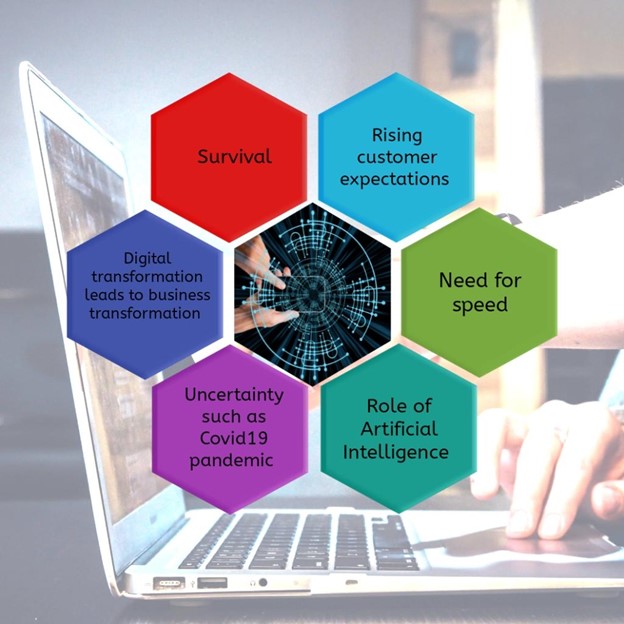
1. Survival
In today’s world, survival is a driver for digital transformation. No business can afford to ignore the need for business process automation. Advanced analytics, cognitive computing, and the Internet of things are making all businesses digital. Digitalization has opened the doors to new opportunities and revenue streams.
The idea of digital transformation has evolved from a buzzword to an essential business strategy for every enterprise. It refers to the organization’s ability to change itself through technology, innovation, and creativity in order to create digital value for its customers. In fact, if companies do not embrace these changes, they will miss their market’s expectations. According to Gartner, CIOs who cannot provide an up-to-date digital vision have no business heading a company in today’s highly competitive environment.
Digital transformation initiatives are becoming more urgent by the day for enterprises around the world.
2. Rising customer expectations
Customer expectations are on the rise and brands are adapting to this trend by integrating digital optimizations into their product development. The main reason for this is that customers want a high level of personalization and want to be able to play a key role in the process of product development. The digital age has brought many new challenges, but also many opportunities for brands, and they have been getting creative with ways of meeting customer needs.
For instance, some brands have turned to influencer marketing, while others have integrated social media reaction buttons on their websites and online catalogs so that customers can provide feedback and recommendations to one another.
The best way to attract and retain customers is by providing them with products that meet their personal preferences. This can be achieved by using different data points that are related to the customer’s online activities. Using products like Microsoft Dynamics 365 for customer engagement, companies can gather data points in order to analyze the online behaviors of their customers. They can then segment them into different groups based on things like gender, age, location, income level, and so on. When companies are able to identify how each group of customers is unique, they can then provide them with products that match their needs more accurately.
3. Need for speed
Speed is a critical driver for digital transformation. With the fast pace of technological changes, firms are now facing the need to either adapt or perish. This is why organizations must shift their mindset and recognize speed as a core value.
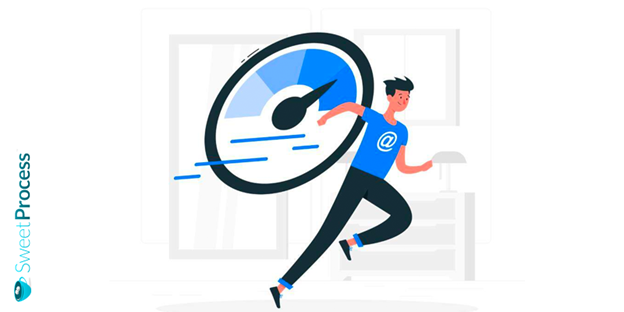
Speed is no longer just about the ability to launch new products or services faster than competitors. Competition in most markets has become so intense that companies simply cannot afford to have an organization that does not understand the meaning of “launch” anymore. The modern business environment is simply too volatile for this type of behavior.
Speed is the ability to create value and add business value faster than new competitors can add theirs. This is why all firms must build an organization that delivers customer value on a continuous basis, rather than at specific points in time or around specific events such as product launches or conferences. These are the new differentiators.
Speed is the only way to win in an increasingly connected and transparent world. Speed allows firms to identify where they need to be and create a strategy to own that position.
Speed is the only way to stay relevant over time. The pace of change today is so fast, any organization that does not know how to take advantage of it will see its competitive edge erode quickly.
4. Role of AI
The role of artificial intelligence in driving digital transformation is very crucial. With the use of AI, enterprises are able to become smarter, more productive, and better connected with their customers. The newly developed technologies which are based on AI will decrease the time needed for employees to complete tasks.
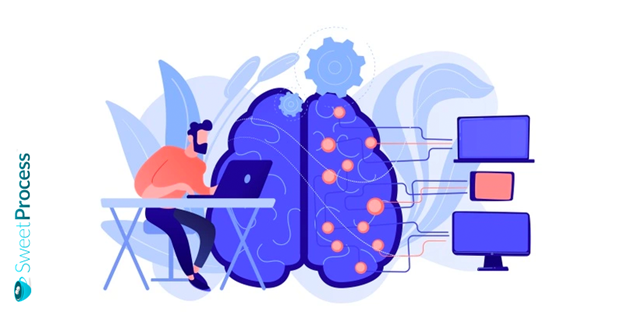
AI-based enterprise solutions are also impacting business models profoundly. The enterprises are enabling AI-based systems to work with clients, which enables them to give personalized services and support every customer request without any hiccup. Lastly, there is an increased need for developers who specialize in this field so as to keep up with the latest trends of technology.
5. Uncertainties such as the COVID-19 pandemic
The COVID-19 crisis has given rise to an era of unprecedented growth in the digital and e-commerce sectors, which is sure to last for many years. The emergence of this global pandemic provided us with a point at which we could look back on everything that had happened up until then as well as take stock before looking forward into what might come next.
The COVID-19 outbreak forced many changes across industries worldwide including how people shop online or use their mobile devices while traveling abroad. These technologies are now more accessible than ever before.
As the world struggled with lockdown after lockdown, businesses and consumers increasingly turned to e-commerce. By 2020 it had climbed from 14% global retail trade in 2019 to 17%. As seen through this new report by UNCTAD & ETrade, COVID-19 and e-commerce: a global review for all partners reflecting on powerful industry transformations throughout 2020.
6. Digital transformation leads to business transformation
The goal of digital transformation is to deliver new value and capabilities for the business. The effects can be found throughout the organization, from salespeople who close more deals to marketers who create personalized campaigns, or developers who build innovative products. These changes may not immediately improve your bottom line, but they will lay the foundation for sustainable growth.
When all of your employees understand the value of digital transformation, they are more likely to help their teams adopt new technologies and strategies. They also can better contribute to decisions about what projects should get priority.
As a leader, you need to set the right tone by clearly communicating that digital transformation isn’t just another IT project or a trendy business buzzword.
It is not just a superficial change in the IT department, but it has to permeate the whole organization from the top down. The digital transformation will lead to business transformation when everyone in the organization buys into it and acts upon that change with commitment, discipline, and, most importantly, passion.
Chapter 4: Digital Transformation Technologies
From the rise of smart homes and the IoT to digital transformation technologies, we’re living in a world where technology is becoming more central than ever. It’s no surprise that businesses are looking for ways to keep up with this trend and find new ways to enhance customer experiences through technology. If you want to stay ahead of the curve, here are eight digital transformation technologies your business should be exploring.
1. Cloud computing
With the onset of the digital age, computing has moved to the cloud. This is when data and resources are stored on servers that can be accessed by users easily or without manual input. The overall objective is to simplify the technology for everyone so that it’s more accessible to people with no computer skills.
According to Forbes, there are many benefits to cloud computing. It makes the data accessible over different platforms which means that users can access their data wherever they go. The user has full control of what is stored in the cloud as well as who sees it. Cloud computing also helps companies because they can store more data without buying expensive storage.
There are, however, some disadvantages to cloud computing. The overall security of the data has yet to be tested. Since it is connected to many servers, usually all over the world, the risk of crashes increases as well as the risk of data loss. There is also a question of whether companies should take full responsibility for storing sensitive information.
Examples of cloud computing include:
Netflix
Netflix is a company that began using the cloud in 2008. It claims that its 117.58 million global customers view 140 million videos each day. What’s unique about Netflix is that they started using cloud technology when it was relatively new.
Google Drive
Google Drive was first released to the public in 2012, but it had existed before as a product for businesses.
Dropbox
Dropbox was first created in 2007. It was invented by the founder of Geni, Arash Ferdowsi. The first consumer version was released in 2008, but it has since grown into a company that offers many other products.
Dropbox is mostly used for file storage and syncing between devices.
2. Mobile technology
Mobile technology refers to mobile computing devices like smartphones and tablets. Mobile phones can be used with handheld computers like laptops and tablet PCs. Such handheld computers and smartphones are also mobile technology.
Mobile phones, smartphones, and tablet PCs have become widespread around the world in just a few years when companies like Apple introduced their iPhones and iPods. Mobile technology allows people to access information anytime and anywhere they want. Using mobile devices such as smartphones is revolutionizing how we do things today, from banking and shopping to even accessing government services and travel information.
Mobile technology has taken the world by storm and it will continue to change the way we do things in the future, especially with advancing technologies like augmented reality, machine learning, and artificial intelligence.
People use mobile devices not only for communication but also for entertainment (games, music), business (accessing email, office files, documents), education (access online courses, learning materials), health care (monitoring exercise routines and diet), and others. Mobile technology can also be used in agriculture for monitoring plants’ conditions and harvesting crops.

Mobile devices like smartphones are changing people’s habits. Some people may develop nomophobia or no-mobile-phone phobia, which refers to anxiety or panic attacks when people are separated from their smartphones. Some people cannot live even for a day without having their phones with them because they need them for work, entertainment, and other uses. Mobile devices have become an integral part of our lives and will continue to be integrated into the way we do things in the world.
3. Digital twin
Digital twin is a technology that has been used by NASA to create virtual models of the International Space Station. Now this technology is getting more and more popular in the industrial business such as manufacturing. It is a technique to create a virtual representation of an object or physical system that can be applied for various uses such as sensing, analysis, training, and simulation.
It was first introduced by virtual reality pioneer Jaron Lanier, who referred to it as a “counterfeit reality,” or a second self.
Digital twin is the virtual counterpart of the original product. It is a replica in which you can simulate changes in different conditions and create alterations in the real object without changing it physically. For example, if you want to change the oil in your car but don’t want to do it you can heat the engine in your digital twin, then you can see how oil will change its viscosity at different temperatures.
Digital twin has enormous application possibilities in all industries because it simulates changes in real-time and it can simulate them without the need of putting the actual machine on track.
Digital twin is a promising technology that has so far been used in a variety of industries such as medical, military, and aviation. It is already being used in the engineering industry too because this technique offers great support for the creation of products that are safe, less costly, and more efficient.
Here’s how some companies have been using digital twin:
Prototype creation: It can be used to get a better understanding of how a model behaves before it starts production. In this way, digital models will allow designers to create prototypes that have more accurate specifications. This means that prototypes can be improved from the design stage onward without ever going into production. Prototypes created from a digital twin reflect on what happens when a real product is put in a real environment.
Lesser costs: In engineering, prototyping often translates into building physical models which can be very costly. Digital twin makes prototyping more affordable and efficient as it does away with the need for physical models that may only serve to indicate what a model might look like. Digital twin also enables companies to efficiently distribute 3D CAD models and make small modifications without having to build a new physical model.
Product safety: Digital twin allows companies to test products in virtual environments. This can be done in different ways such as by creating an engine on a computer then making it run under certain conditions. Doing so reduces the risk of physical damage that may be caused by testing products in real-time.
Reduction in the number of errors: Digital twin enables companies to detect patterns that might otherwise go unnoticed before they become problems. For example, if an engine isn’t working as well as it should, the digital twin model will show where there might be a problem even before any physical changes are made. This means that errors can be identified in the early stages before they become problems and the chances of making a mistake in production are significantly reduced.
4. Internet of things (IoT)
The Internet of things, or IoT, is the idea that everyday non-computer devices can be connected to the Internet. This connects these devices to people, other devices, and systems through this network. With this ongoing digital transformation, the number of IoT platforms is on the increase.
To successfully build any application, it needs to be developed on a platform that enables development teams to design and develop IoT solutions rapidly. In addition, the selected platform should provide an enhanced user experience for end-users.
Top IoT platforms in 2021
- Google cloud platforms
Google provides an intelligent IoT platform that is currently one of the most popular in the world. It provides smart homes, connected cars, and robotics, among other applications the ability to set-up a user-authenticated device model. It allows users to integrate devices and build more intelligent products with the help of an IoT cloud platform.
- Cisco IoT
Cisco is a great cloud-based platform that provides an IoT application. Its f
-ocus is mobile operators. It allows one to integrate all IoT devices into a SaaS solution by ensuring seamless cellular connections.
- Voracity
IRI Voracity is a great tool if you want an all-in-one data management platform to implement an IoT data control at every stage in your business process. The platform employs two engines to process huge data: IRI CoSort and Hadoop.
- Particle
Particle is the best option for developers who want to create their own IoT solutions. They offer everything from production modules and asset tracking teams all the way up through end-to-end services, giving you a one-stop shop when it comes time to develop your product!
- Salesforce
Salesforce has been using IoT technologies to expand their customer relationship management business. The Salesforce IoT Cloud platform collects data from connected devices, and then delivers a more personalized experience by transferring it straight into the CRM system for context-based activities right away.
- IBM Watson IoT platform
IBM is a leading provider in developing platforms that aid developers in building devices and services through machine learning and cognitive capabilities. The software helps to digitize business processes and helps in making decisions using IoT data. It provides cloud services that allow users to build, deploy, and manage their applications. It also enables developers to create IoT products through data aggregation, device management, and security.
- ThingWorx IoT platform by PTC
This platform provides a comprehensive suite for developers in the IoT market. The multi-tenant platform allows users to create applications that are scalable and secure.
- Amazon IoT device management
Amazon manages the different devices that use Amazon Web Services IoT service through its platform. The platform allows users to manage devices using unmatched scale. It also enables developers to gain access to the latest software that is available on Amazon.
- Microsoft Azure IoT Suite
This is an intelligent platform that allows its users to build real-time solutions with the help of a comprehensive set of tools. The platform is easy to use and it enables users to create apps with the Internet of things where they can connect, collect, and analyze data.
- Oracle IoT cloud service
This is a cloud platform that allows users to collect and manage data from different devices. It offers a simple yet powerful suite for developers in IoT application development.
It also provides tools that are essential in security, connectivity, and data management.
5. Robotics
Robotics is the design, development, operation/programming of robotic devices. These are machines that can do tasks on their own, without any kind of control by humans.
They are automated with sensors and software, so they can “react” to things in their environment with varying degrees of autonomy. They are used in many industries for the production of consumer products, but also military purposes.
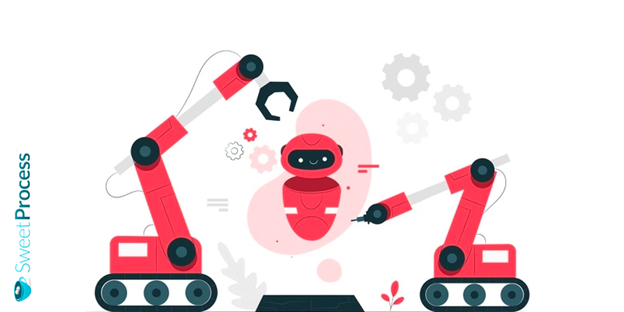
A robot is a device that can be programmed to do tasks autonomously or semi-autonomously. The word robot can refer to both physical robots and virtual software agents, but the latter is usually referred to as bots.
A humanoid is a robot with an appearance that resembles the human body. Humanoids are defined by their similarities in shape or form to humans, which can include actual biological structures like muscles for posture support and joints for lumbopelvic stability, as well as softer elements like body hair and simulated skin.
In some areas of robotics, such as manufacturing or assembly tasks that involve transporting objects, the robots have to understand what they “see” in their environment and how to handle these objects. Normally, robots can be programmed to process images for a specific application, but it is difficult to program all the necessary capabilities.
Industries that use robots include:
Automotive: Robots are increasingly used in the automotive industry for welding and for inspecting cars, which can reduce the need to use human inspectors or welders.
Architecture: Robots are increasingly used in architecture for tasks such as repetitive design and construction work, 3D modeling, and laser cutting/etching.
Agriculture: Agricultural robots that autonomously plant, tend, and harvest crops can significantly reduce labor costs and increase worker safety.
Construction: Construction robots such as bulldozers and miniature robotic arms can reduce labor costs by carrying out tasks such as paving roads or laying bricks.
Food service: Restaurants and catering companies use foodservice robots to automate certain tasks, such as preparing food or serving customers.
Military: Robots are now being developed for military purposes by many different countries. Military robots are being developed to perform a variety of tasks, including reconnaissance in dangerous areas, detonating explosives when finding them, and patrolling intruders.
Healthcare: Healthcare robots such as the Care-O-bot and Paro are being developed to assist elderly people and children, provide companionship for elderly people who live alone, and entertain hospital patients.
Home appliances: The First Faucet Bot is a robot that washes dishes automatically. It provides many advantages over human dishwashers, such as the ability to clean glasses on the inside and the outside at the same time.
Home security: Many modern home security systems use robots for surveillance, which can use facial recognition to identify potential intruders and distinguish between humans and animals. Robots such as iRobot’s Roomba, is designed to clean floors and empties on its own.
Education: Robots are used to teach children everything from simple math to complicated physics.
6. Artificial intelligence and machine learning
AI is when a computer imitates certain behaviors associated with being alive. Machine learning is a type of AI where software can study data and learn from it.
In the context of digital transformation, most people who use these terms are referring to machine learning. In a nutshell, machine learning is a type of AI that allows computers to study data and learn from it.
AI and machine learning for business: What’s the difference?
The reason we’re talking about this now is that many businesses, large and small, see a huge opportunity to use this technology in their business. There are entire markets built around these tools (like search engines and social networks), and it’s now becoming possible for many companies to use machine learning themselves without hiring a large team of data scientists.
AI and machine learning: How do they relate?
Machine learning is a subset of artificial intelligence. However, certain subsets within AI called narrow AI can’t properly be considered machine learning.
Artificial intelligence (AI) vs. machine learning (ML) differences are explained with examples.
Machine learning is one of the most talked-about technologies right now, but there are only a handful of people who know what it is. Here’s everything you need to know about machine learning vs. AI, including common misconceptions and how they’re different.
Google is making some great strides in the AI space. They’ve begun to develop AI-based chatbots that can interact with people in natural ways, they’re teaching cars to drive themselves, and they’re even developing a system that can detect diabetic retinopathy. Google is also making its machine learning tools available to the public.
Uber
Uber has already used machine learning to create the ideal pick-up location for customers. They use deep learning algorithms to determine where people are looking for cars, which has helped them understand the preferred pick-up locations. Uber has also begun using machine learning to determine how long people may wait for a car. They use machine learning to track how people move about and look for their cars, which allows them to predict pick-up times.
IBM
IBM is one of the leading companies when it comes to machine learning. They have begun to offer their machine learning tools to the public, allowing anyone to develop machine learning systems. One of IBM’s most popular machine learning tools is Bluemix, which allows for the development of apps that can use machine learning technology.
IBM’s Watson is making strides in medical and finance industries
Watson is currently being used in the medical field to aid doctors with their diagnoses. The goal is for Watson to go through all of the latest research papers and then present the most likely diagnosis to doctors. In the past, Watson has been programmed with a list of conditions, but it’s now being expanded to include probabilities associated with each diagnosis.
Watson is already being used in the finance industry to mine data and provide possible investment solutions. One of the most common uses for Watson is to develop a list of profitable stocks. IBM has also developed an app that will determine how easily a person is distracted.
7. Augmented reality
Augmented reality technology lets the user view the virtual objects that are modified or made more visible by their real-world surroundings. For example, it can be used to blend real-world objects with virtual images or to display information in the user’s field of view.
This technology is primarily being deployed in applications related to entertainment, marketing, or human interaction. There were several early successes in augmented reality technology in the 1990s and 2000s where VR games sometimes found a use for it.
But now augmented reality has matured enough to go beyond niche applications and become a part of the mainstream consumer market as well, with several exciting developments since 2017. In fact, according to IDC, spending on AR hardware is expected to be $72.8 billion by 2024. Below is a list of eight amazing augmented reality applications that are sure to be big hits in the coming years.
Google’s foray into the wearable technology market was met with both excitement and concern, but it still managed to make its mark on the history of AR technologies. That’s because it is one of the first devices that can be considered an AR headset or visor.
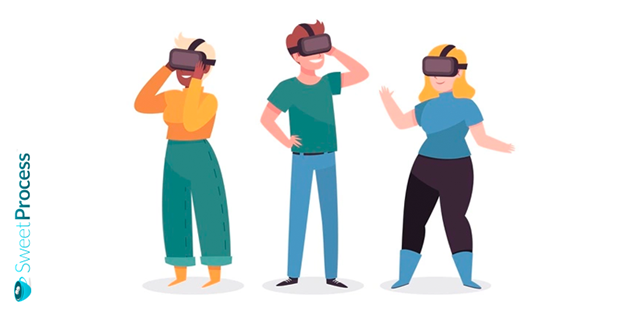
The device was unveiled in 2012 and the final product hit the market a few years later thanks to some updates. However, it only lasted as a developer edition as it wasn’t successful enough as a consumer product. The main reasons for this were privacy concerns over its camera and the fact that it was quite pricey.
The device comes with a projector that displays on the inside of the glass. This makes it very easy for others to see what the user is looking at, unlike a smartphone screen where you have to be looking directly at it. The device was not a commercial success but it is an important milestone in the development of AR technology that will undoubtedly be remembered for years to come.
Snapchat is an instant messaging and multimedia app that is popular among the youth. It has been gaining prominence over the past decade with its unique approach to multimedia messaging and photo sharing. In 2017, the app introduced a major update that would change the future of augmented reality apps. It allowed users to overlay virtual objects on top of their selfies. This meant that augmented reality can be used in videos and photos in a way that was not possible before.
The 3D lenses were first introduced with an animated dog’s head, which you could place on yourself or any other person in the photo. This was followed by many other creative lenses for making cool videos or just putting hilarious effects on people’s faces.
These lenses were a huge success and helped the company to double its revenue from $149 million in 2016 to over $286 million in 2017.
Ikea’s New AR App
Ikea is a Swedish home furnishings company that has been around since 1943. But in 2017, the company introduced its first augmented reality app. This app essentially lets you see what Ikea furniture will look like in your home before actually purchasing.
8. Additive manufacturing
Additive manufacturing technology is also called 3D printing. It is a process of making three-dimensional solid objects from digital data. It is an efficient, cheap, and fast way to produce customized products.
This technology has been used since the last decade but now has become more popular. Although many developed countries are still using this technology, there is a lot of scope for improvement in the market.
Three-D printers use digital files for printing physical objects. This works with additive processes which means printers add material layer by layer to build 3D models. It can also be used for subtractive processes, which means the printer can remove material from a block of material to create a 3D model.
Ericsson has used this technology to increase the customization of devices. This helps in cost reduction and time efficiency. GE has also started using this technology for reducing costs and its response time for repairs.
GE is a well-known American multidimensional conglomerate with multiple divisions in the engineering industry. It designs, manufactures, markets, and services products like jet engines, gas turbines, locomotives, healthcare systems, and many more.
Unfortunately, during one of the engine test trials, a defect can be seen on its blades which ultimately caused J4 to fail. The engineers at GE decided to use additive manufacturing technology so that they can print a metal part for this defective engine. They designed a replacement metal 3D printed blade which now powers commercial airliners.
This technology is also used in the space industry, and NASA has used this technology to create a shield for radiation protection.
Chapter 5: The Six Building Blocks of Digital Transformation
Digital transformation is made of six building blocks. These are strategy and innovation, customer decision journey, process automation, organizational culture, technology, and data analytics.
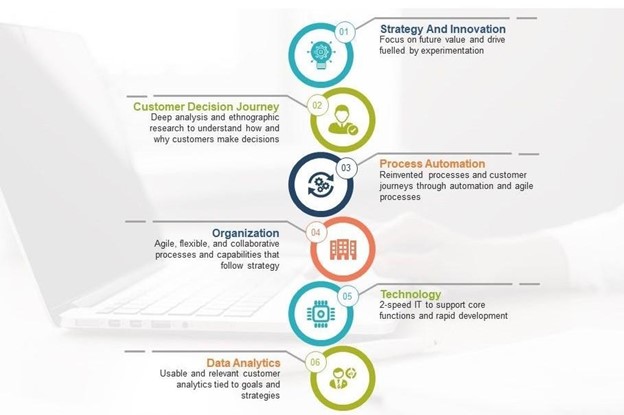
1. Strategy and innovation
This includes identifying a strategy for digital transformation, and setting a vision and defining objectives to be achieved over the coming years. After all, without clear goals, it is impossible to correctly manage each of the other five building blocks. In addition, it’s crucial that we choose which tools will help us to reach our objectives.
The specific tools that will be implemented by each organization naturally depend on the current state of the company, its strategy, and where it wants to go with this digital transformation process.
Innovation pertains to identifying what innovations are already available within the company. Which departments are responsible for which areas is also very important—it’s not acceptable to have organizational silos where groups become isolated from one another. Those barriers must be broken down so that each group is knowledgeable of every project being executed by the organization.
2. Customer decision journey
It is necessary to develop a customer-centric strategy with insights on how to transform organizations into the future. Digital transformation is not just about technology, but rather turning your company around by looking at it from an omnichannel perspective that is seamless and personalized for individual customers.
The customer decision journey is a personal and emotional journey that varies from person to person based on their individual needs, objectives, and preferences. It can happen at any moment in time, but it always starts with the customer’s need or problem that leads them to search for information about what they want and need to buy.
A recent study by McKinsey & Company defined a new approach to the customer decision journey. They found that 75% of purchasing processes now occur outside traditional “buying channels,” such as in-person or over the phone, and the percentage keeps rising.
The customer decision journey helps companies with digital transformation by providing a roadmap of what customers want at each point in the buying process. It also allows businesses to develop useful features that encourage customer loyalty, increasing brand value along the way.
3. Process automation
The world is on the cusp of a new era where machines will coexist with humans in more and more spheres of life. The first trend that we see in this consortium is automation. In order for organizations to transform quickly as new technologies emerge, they need to automate as much as possible. For instance, new technology like AI can automate data gathering and analysis. AI can also automatically produce models that the business can then use to make more informed decisions.
Process automation can also remove human error from critical processes. For example, humans are prone to errors in manually following instructions on how to capture data or create records. As new processes are introduced, digital transformation cannot happen without process automation tools like robotic process automation (RPA).
4. Organizational culture
This denotes how an organization’s employees perceive innovation within their company, as well as how they interact with new projects and products. It should be clearly communicated to employees that digital transformation is not only about generating new ideas but also about implementing them within the company. As a result, everyone will hopefully see it as their responsibility to contribute toward this goal of becoming a more innovative organization.
5. Technology
Technology is the foundation for digital transformation. It enables organizations to rethink their business, leverage new trends in cloud computing, create personalized customer experiences, and generate new revenue streams.
But technology is a means to an end, not the destination—and it’s not enough. It’s what you do with technology that delivers value.
Digitization requires a step-change in the way businesses work: rethinking business models, improving efficiency and effectiveness through automation, and streamlining processes from procurement to delivery. This is what we mean by digital transformation.
6. Data analytics
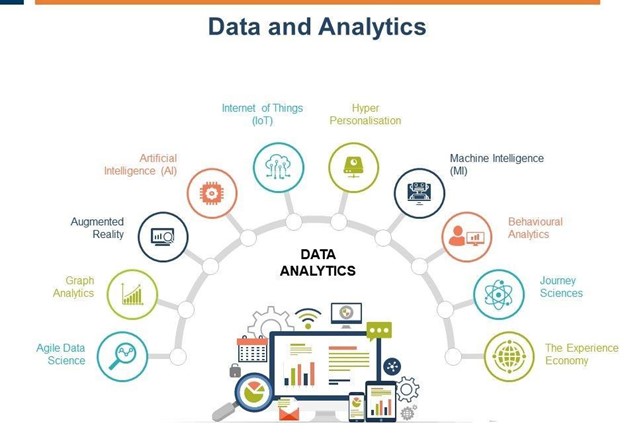
Data analytics is a tool for building better relationships with customers, even if some of those customers are not yet customers. Today’s digital convergence has been driven by data analytics as more and more customer interactions move to the digital space. We’ve seen this in how people use Facebook, Google, and more recently Snapchat as a way to connect with friends and reach out to new connections. Data analytics also helps create better relationships with suppliers through automated processes that require less administrative handling and less effort on the supplier side.
All of the digital convergence with applications, social media, big data analytics, and more has placed a focus on creating relationships between businesses and customers.
Now you know how to start transforming your company. Digital transformation is not only a buzzword but a real process to embrace if we want to take our companies into the future. We have never been more interconnected as a society, and businesses that aren’t embracing this new reality will quickly find themselves falling behind.
If you think about it, digital transformation could be the very reason your business exists in the first place.
Companies That Have Undergone Digital Transformation
Some notable companies that have undergone digital transformation are Google, Walmart, and McDonald’s.
Google transformed its business by leveraging data science to provide the solutions that it needed. This helped them to maintain consistency in user experience, meet customer demands, and reduce costs.
Google’s data science enabled them to catch the trends in search before others could. They used this information to dictate what ads were displayed, thus displaying more relevant ads for users.
The company also leveraged advancements in machine learning to create DeepMind, an AI system that saw an increase of 50% in Google’s core product offerings. DeepMind was able to read 1,000 times faster than the human race which allowed it to integrate with thousands of other AI systems at once. This meant it could map out trillions of possible game moves during a game like Go or teach itself to operate a car.
“If you’re not operating at machine speed, you will lose.” —Sundar Pichai
Walmart

Walmart transformed its business by creating a presence online and merging the online and offline shopping experience. They removed friction in the customer journey by offering free shipping, increasing the speed of delivery, and introducing shelf-scanning robots to automate the inventory scanning process on the shelves.
They also introduced new checkout options, such as self-checkouts, pick up, and delivery, which eased customers’ shopping experience and eliminated wait and add options at the register.
McDonald’s

McDonald’s transformed their business by bringing the customers what they wanted in the way that they wanted it. They allowed their customers to choose what they wanted on their burgers, allowing them to experience the brand in a new way.
McDonald’s was one of the first fast-food chains to introduce self-serve kiosks in their restaurants. This enabled customers to experience personalized service, faster transactions, and quick turnaround times.
The introduction of these kiosks also saved the business money in employment costs while increasing revenue by 10%.
Chapter 6: The Future of Digital Transformation
Yes, the Internet is an important part of our lives. It has become a form of communication that is used by billions of people every day. It’s also becoming an increasingly common topic in the media. The future of digital transformation will be very different from what it was ten years ago. It’s changing so much that it’s tough to predict. Digital transformation is being driven by globalization, cloud computing, social media, and artificial intelligence, to name just a few factors.
The following are some notable trends in the future of digital transformation:
- An increase in the implementation of digital transformation strategies is on the rise. Digital transformation is changing our daily lives. It offers new solutions to some of our biggest problems. For example, it can help us to overcome stress, loneliness, and depression. Digital transformation has changed the way we see ourselves and each other. In addition, it has also helped us to embrace change which is a positive step toward a better and more sustainable future. Digital transformation has changed the way that we interact with each other as well as how we interact with machines.
- Greater investment in IT and skills is needed to keep up with digital transformation. Digital transformation has changed the way people work. We are becoming more connected than ever before, and with that comes new opportunities. We all need to adapt and learn new skills that will help keep up with this transformation.
- Big data analytics will play a vital role in digital transformation. Big data analytics is used to gain insight into the behavior of users with the goal of improving their experience. Big data analytics provides a competitive advantage to businesses by providing valuable insight.
- The IoT is also known as the Internet of everything (IoE). It’s predicted that by 2030, 25.4 billion objects will be connected to the IoT as opposed to 10.7 billion in 2021. The Internet of things can deliver many business benefits including increased efficiency, better customer insights, and improved productivity.
As the number of connected objects is predicted to grow, so too will the capability of IoT systems. What most people don’t realize is that IoT is also expected to grow at a faster rate than the number of connected devices over the next few years. This means that most businesses will be able to benefit from IoT in some way or another. As we forge ahead, more and more companies will be able to see how it can improve their day-to-day operations and efficiency, as well as provide them with greater insights into their customers.
- Ahead of 2022, artificial intelligence (AI) will be everywhere, adding billions of dollars to the global economy and transforming how we live. AI is not just for business; it will be integrated into all aspects of our personal and professional lives.
Humans will rely on AI for everyday activities, from booking an airline ticket or setting an appointment to saving lives. AI will also be used to counter cybersecurity threats.
The reliable and trustworthy AI of today will be supplanted by more powerful and sophisticated versions tomorrow.
Chapter 7: Challenges to a Successful Digital Transformation Strategy
For organizations to succeed in their digital transformation efforts, there are a series of challenges that might likely occur:
- Alteration of organizational structure
The introduction of new technologies and a culture change are some of the challenges companies may face while implementing a digital transformation strategy. In order to succeed, a digital transformation strategy has to be supported by the overall company-wide strategies and goals. A common pitfall that usually occurs is not taking into account the entire company and its needs. This can lead to a mismatch between strategy and employees which ultimately ends up in failure.
- Cooperation and coordination between departments
This is key to a successful digital transformation strategy. Departments need to be able to work closely with other departments, sharing information like strategy, and becoming flexible in order to achieve the overarching company goals.
- Budget and resource allocation
These are issues often raised during digital transformation. Since it can take years to create a successful transformation, the C-level has to ensure that there are sufficient financial resources for this.
- Full backing of the leadership team
This is extremely important to implement a successful digital transformation strategy. This is not only because they are the ones who have to set the tone but also because they are the ones who will have to review the outcome of the project.
- Regulatory and legal compliance
This must be considered when creating a digital transformation strategy. A digital transformation can change the way employees, customers and partners interact with each other and the company, and therefore needs to be compliant with local laws and regulations.
- Security and privacy of data
For a digital transformation strategy to be successful it has to take into consideration the security and privacy of data. Users, competitors, or even governments can potentially take advantage of information exposure and therefore the company should ensure that their privacy is protected.
Chapter 8: How SweetProcess Can Help You Achieve Digital Transformation
Business processes are the foundation of every business. They define how you do everything from hiring new employees to onboarding them, from creating products to delivering them, and from managing your customers to collecting their payments.
But manually running these processes is a huge waste of time for everyone involved in the process. It’s also error-prone because humans make mistakes all the time—we’re only human!
SweetProcess automates your business processes so they run on autopilot, saving you hours each week and reducing errors by up to 80%. This means that you can spend more time growing your business instead of wasting it on repetitive tasks. You’ll also have access to an easy drag-and-drop interface so anyone on your team can create new automated workflows in minutes.
A lot of organizations have embraced SweetProcess to help transform their businesses digitally. Take a look at how we helped them out:
Chris Dunning and Mark O’Dell, CEO and operations director of TechQuarters, talk about how they were experiencing issues with tribal knowledge as a result of their expansion. There was a need for their business processes to be streamlined in one central system, and at the same time be accessible to everyone. In their quest for solutions, they stumbled upon SweetProcess and have never been happier. The company now enjoys:
- Effective documentation
- Centralized knowledge base
- Improved customer satisfaction
- Employee training, onboarding, and offboarding
- Document versioning
They now operate seamlessly and focus on providing great service to their customers.
Lisa Phillips, who is the group general manager of the integrated building services company Aizer Group, talks about how SweetProcess was used to facilitate remote work and empower its employees. The company didn’t have a process documentation software where they could document their procedures, and this led to delays whenever Lisa wasn’t available. They also wanted to expand their offshoring staff and realized that there was a need to upscale their business processes.
Lisa decided to leverage technology as opposed to the DIY method they were using previously, and they found SweetProcess. These go-to documents, which they found easily in SweetProcess, were grave restrictions that were affecting their discharge of duties. Some of the benefits they got from using SweetProcess include:
- Simplicity when mapping out processes
- Reference document for employees
- Speedy training and learning
- Saving money and time
Another great company that has been able to improve business sales is Good Nature Organic Lawn Care. Good Nature Organic was concerned with documenting procedures, and employees had a problem with the lack of clarity in the manual procedures they were using. Alec McClennan, the CEO, explained how SweetProcess helped them to increase sales by streamlining business processes. After signing up with SweetProcess, they have become more efficient, provided better service to their customers, are able to upscale their business and have a central standard operating procedure across the board.
Conclusion
You’ve seen the headlines. The world is in a digital transformation, and you need to be ready for it. But how do you know if your company has what it takes? We’ll help make that assessment simple by providing six steps on achieving complete digital transformation. First thing’s first—download our free PDF for assessing your company’s readiness level. And don’t forget about SweetProcess!
Our team members are standing by to offer you a free trial of our popular suite of tools so that you can get started right away even if your company isn’t quite there yet.

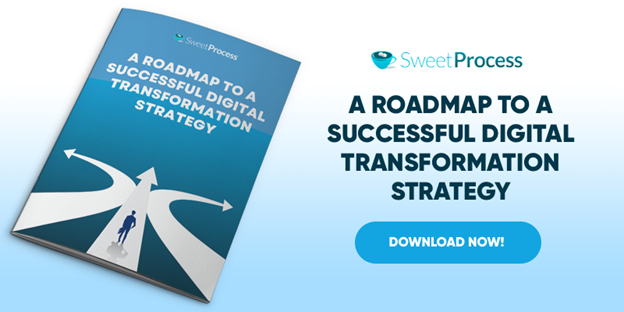








Leave a Reply